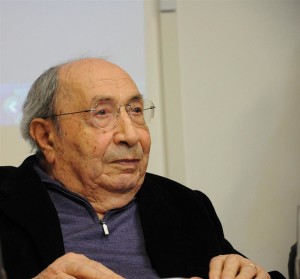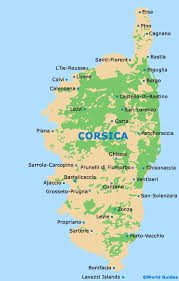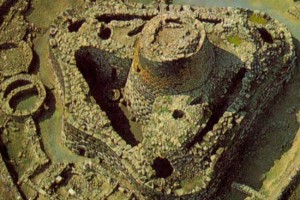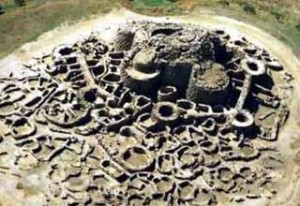Nuraghic
Lilliu, Giovanni (t)
Giovanni Lilliu (1914-2012) was a highly respected Sardinian archaeologist and politician. He was  also a recognised expert on the Nuraghic culture of Sardinia. His contribution to the Atlantis debate is to locate the Pillars of Heracles at the Strait of Sicily or more precisely at Cape Bon in Tunisia and Lilybaeum in Sicily.
also a recognised expert on the Nuraghic culture of Sardinia. His contribution to the Atlantis debate is to locate the Pillars of Heracles at the Strait of Sicily or more precisely at Cape Bon in Tunisia and Lilybaeum in Sicily.
Corsica .
Corsica together with Sardinia was the home of megalith builders long before it became an Etruscan colony. The island was seldom mentioned as a  location for Atlantis until the end of the 18th century when>according to Joscelyn Godwin [0746.36],<Antoine Court de Géblin proposed Corsica and Sardinia as the location of Atlantis.
location for Atlantis until the end of the 18th century when>according to Joscelyn Godwin [0746.36],<Antoine Court de Géblin proposed Corsica and Sardinia as the location of Atlantis.
>However, Atlantisforschung claims that as far as is known, Corsica was first associated with Atlantis, later, in 1840. At that time it was the lawyer Angelo Mazzoldi, an ardent Italian nationalist, who claimed in a treatise that Italy had once been Atlantis, the center of which was somewhere near Corsica. He dated the sinking of Atlantis to 1986 BC(e).<
Corsica did not feature again for over a century until 1929 when this idea was proposed at a meeting of the Society for Atlantis Studies, held in the Sorbonne in Paris, a delegate threw two tear gas bombs in order to prevent the dissemination of such ‘heresy’.
It may be worth considering that the Weshesh, listed as one of the Sea Peoples, have been identified with the inhabitants of Corsica among others. In the latter part of the 2nd millennium BC, a civilisation known as the Torreans occupied the region around Ajaccio. Like the Nuraghic people in nearby Sardinia, they also built towers, but smaller in size.
Before the Torreans, there was a string of megalithic dolmens stretching from southern Corsica across to northern Sardinia as if outlining a pilgrimage route. Frederico Bardanzellu’s website(a) offers more information on this and other aspects of the prehistory of these two islands, including a study of any possible astronomical significance that might be deduced from the orientation of the dolmens on both islands.(d)
Luigi Usai is currently (2021) promoting [1814] the idea that a conjoined Sardinia and Corsica had constituted the island of Atlantis!(c) He has named Sulcis at the southern end of Sardinia as the location of its capital.
In July 2021 I was sent a number of images that purported to show anomalous underwater images in the Central Mediterranean northeast of Malta. At first sight, they appeared to show extensive manmade features. However, further investigation by the person who sent them to me eventually discovered that the images were the consequence of the flawed computer interpretation of sonar data. In December 2021 Luigi Usai produced the same flawed imagery as evidence that he had discovered a lost submerged civilisation!
So that there is no misunderstanding let me state that I have advocated a Central Mediterranean location for Atlantis for some years. If Sardinia and/or Corsica hold that location, I am more than happy to congratulate Usai and Frau. But, I am not convinced by satellite imagery that has so often been proven to be flawed.
The Torreans have only been recognised since 1954, thanks to the work of archaeologist Roger Grosjean (1920-1975). A 1966 article by Grosjean is available online(b). The title of his paper, The Mysterious Horned Warrior – Torreans of the Isle of Corsica, brings to mind the horn-helmeted Sea Peoples depicted at Medinet Habu, a similarity not lost on Grosjean.
‘The Sea Peoples’ have been suggested, by a number of Atlantologists, as a collective name for the Atlantis federation.
(a) http://www.museodeidolmen.it/englishdefault.html
(c) https://www.atlantisfound.it/2021/01/24/why-didnt-scientists-find-atlantis-before-usai-luigi/
(d) https://www.museodeidolmen.it/englisharcheoastr.html
(e) Corsica (island) – Atlantisforschung.de (atlantisforschung-de.translate.goog) *
Nuraghi *
Nuraghic (Nuragic) is the name given to the ancient culture of Sardinia of the 1st and 2nd millennia BC. The current view is that this  Nuraghic civilisation was devasted by a catastrophe, possibly a tsunami, around 1178-1175 BC.
Nuraghic civilisation was devasted by a catastrophe, possibly a tsunami, around 1178-1175 BC.
The etymology of the name Nuraghe is discussed in some detail by Zoltan Ludwig Kruse on Pierluigi Montalbano’s website(h).
It is characterised by ‘fortifications’ of round towers or nuraghi of which there are still over 7,000 to be seen. Robert Paul Ishoy believes that Atlantis was located on Sardinia and that the Keftiu, Atlantean and Nuraghi cultures were all very closely related(c). Sergio Frau, an Italian journalist, has expressed similar ideas in his well-publicised book [302].
American novelist, Francis Levy, has erroneously claimed(g) that Plato had said that there had been 10,000 towers in Atlantis and consequently “One argument would have it that Sardinia was in fact the lost civilization of Atlantis, which became buried by water when the Mediterranean rose.”
A very interesting site covering the subject of nuraghi structures is noted below(a). The design of the later and cruder giren of Malta (see M. Fsadni’s book[595]) and the bunje of the Adriatic would appear to have derived some inspiration from the nuraghi. Located on the Skellig Rocks off the south-west coast of Ireland are old monastic ‘beehive’ stone huts similar to the ‘giren’. It is also worth mentioning that Robert Bauval photographed a number of towers in the interior of Oman(b) comparable with the ‘nuraghi’.
The El Agujero site on Grand Canary Island would seem to share layout similarities with some of the nuraghi sites. Furthermore, the brochs of Scotland have also been identified as sharing many of the characteristics of the nuraghi, but this is probably just coincidental. If I may digress, many of the brochs were found to have vitrified walls, which to the more imaginative among us suggested ancient atomic warfare(f)! This feature is also to be found in Ireland and mainland Europe(e). A recent study of the Broborg hill-fort in Sweden revealed(d) how vitrification there was achieved, without splitting a single atom.
Ignatius Donnelly also suggested that the Scottish brochs were associated with the nuraghi and goes further suggesting that the round towers of Ireland were the result of similar influences as well as structures in the United States and India, claiming that “it will not do to say that the resemblance between these prehistoric and singular towers, in countries so far apart as Sardinia, Ireland, Colorado, and India, is due to an accidental coincidence.” [1179.418]
It is noteworthy that the nuraghi of the north are generally intact, while those in the south and west are usually found collapsed. In addition, on the Campidano plain in the southwest, there are a number of nuraghes to be found in ‘ooze’ which all point to seismic activity and some inundation. There is obviously more work to be done here.
Giovanni Lilliu has studied the giant broken statues discovered at Monte Prama on the Sardinian Sinis Peninsula and declared them to be nuraghic.
The most extensive of the nuraghi is Su Nuraxi near Brumini, which was only discovered in 1950.
The most dramatic explanation for the construction of so many nuraghi is offered by an American historian, Brian Cairns, who contends that they were built as protection against violent electrical discharges(b)!
(a) Nuraghi: charm in Sardinia 1/6 (archive.org)
(b) Neolithic Man and the Electric Universe – The Thunderbolts Project™ (archive.org) *
(e) https://en.wikipedia.org/wiki/Vitrified_fort
(f) https://ancientnuclearwar.com/
(g) http://www.screamingpope.com/2016/08/sardinia-journal-vii-atlantis.html

